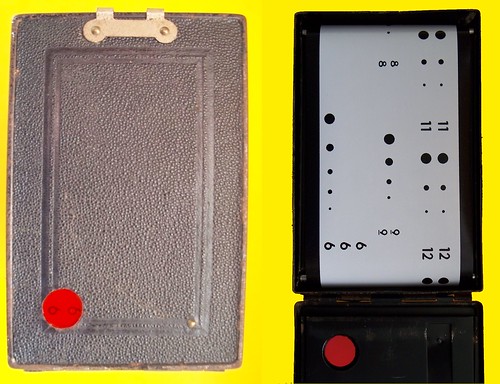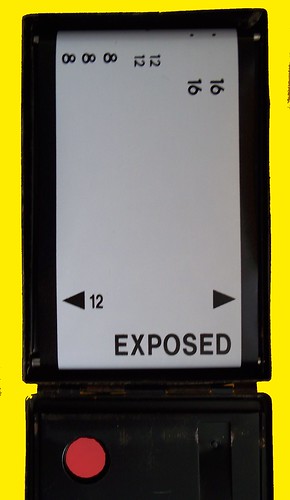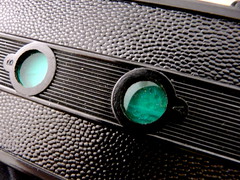Difference between revisions of "Red window"
m (cat: parts) |
Ivanbranco (talk | contribs) (via wayback machine) |
||
| (8 intermediate revisions by 2 users not shown) | |||
| Line 1: | Line 1: | ||
{{glossary}} | {{glossary}} | ||
| − | In 1892 the '''red window''' was introduced by the [[Boston Camera Manufacturing Company]] as a means to control | + | {|class=floatright |
| + | ||[http://www.flickr.com/photos/89864432@N00/2239830515/in/pool-camerawiki http://farm3.static.flickr.com/2027/2239830515_c016f92bca.jpg] | ||
| + | |rowspan=2|[http://www.flickr.com/photos/89864432@N00/2239830517/in/pool-camerawiki http://farm3.static.flickr.com/2163/2239830517_b6faae8264.jpg] | ||
| + | |- | ||
| + | ||Looking through the '''red window''', the number 6 visible is the sixth frame of eight<br/>6×9cm exposures per roll of [[120 film]]. For cameras exposing 6×6 or 6×4.5 images,<br/>the camera's red window would instead align with one of the other rows of printed<br/>numbers, to provide the appropriate frame spacing. | ||
| + | |- | ||
| + | | colspan=2 align=center| <small>images by {{image author|Uwe Kulick}}</small> {{with permission}} | ||
| + | |} | ||
| + | In 1892 the '''red window''' was introduced by the [[Boston Camera Manufacturing Company]] in the [[No. 2 Bulls-Eye]] camera, as a means to control the advance of paper-backed [[rollfilm|roll film]]. Later this simple device became nearly universal for cameras using the popular roll film formats [[127 film|127]] (about 4cm wide) , [[120 film|120 and 620]] (6cm), as well as many older formats such as [[116 film]] which are less known today. The window shows an exposure number that is printed on the film's backing paper. As the photographer winds forward, the appearance of the next exposure number in the window means that the film has advanced enough to avoid overlapping frames. | ||
| + | |||
| + | |||
| + | Because early black-and-white films were quite insensitive to red light, it became standard for most manufacturers to use a red filter over their exposure counting window—a tradition that persisted even after the arrival of [[panchromatic]] films. Some cameras do have a frame-counter window of different color, for example the [[Rollex 20]] (which uses green). | ||
| − | |||
| − | |||
| − | |||
| − | |||
| − | |||
| − | |||
| + | Some cameras use a frame size which is half the standard width. In this case, each number is advanced first to one, then a second window. This was especially common in mid-20th-century cameras for [[127 film]]. | ||
| + | {{Flickr_image | ||
| + | |image_source= http://www.flickr.com/photos/danagraves/6281203298/in/pool-camerawiki | ||
| + | |image= http://farm7.static.flickr.com/6098/6281203298_64884b55f5_m.jpg | ||
| + | |image_align= left | ||
| + | |image_text= Green "red windows," labeled '''A''' and '''B''' | ||
| + | |image_by= Dana Graves | ||
| + | |image_rights= wp | ||
| + | }} | ||
| + | |||
| + | {{br}} | ||
==Links== | ==Links== | ||
| − | * [ | + | * [https://web.archive.org/web/20161024131038/http://silverbased.org:80/load-120-film/ Loading 120 film and using the "red window"] at [http://silverbased.org/ Silverbased] via [http://www.archive.org Internet Archive: The Wayback Machine]. |
[[Category: Camera parts]] | [[Category: Camera parts]] | ||
Latest revision as of 23:53, 18 January 2023

|

|
| Looking through the red window, the number 6 visible is the sixth frame of eight 6×9cm exposures per roll of 120 film. For cameras exposing 6×6 or 6×4.5 images, the camera's red window would instead align with one of the other rows of printed numbers, to provide the appropriate frame spacing. | |
| images by Uwe Kulick (Image rights) | |
In 1892 the red window was introduced by the Boston Camera Manufacturing Company in the No. 2 Bulls-Eye camera, as a means to control the advance of paper-backed roll film. Later this simple device became nearly universal for cameras using the popular roll film formats 127 (about 4cm wide) , 120 and 620 (6cm), as well as many older formats such as 116 film which are less known today. The window shows an exposure number that is printed on the film's backing paper. As the photographer winds forward, the appearance of the next exposure number in the window means that the film has advanced enough to avoid overlapping frames.
Because early black-and-white films were quite insensitive to red light, it became standard for most manufacturers to use a red filter over their exposure counting window—a tradition that persisted even after the arrival of panchromatic films. Some cameras do have a frame-counter window of different color, for example the Rollex 20 (which uses green).
Some cameras use a frame size which is half the standard width. In this case, each number is advanced first to one, then a second window. This was especially common in mid-20th-century cameras for 127 film.

|
| Green "red windows," labeled A and B image by Dana Graves (Image rights) |